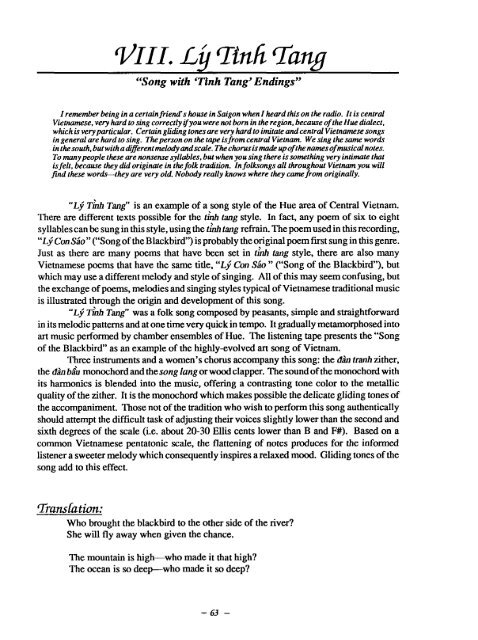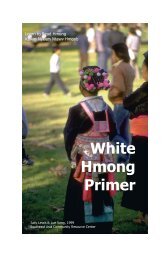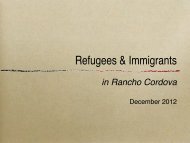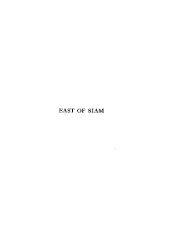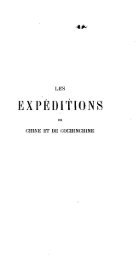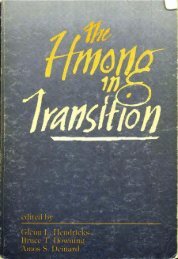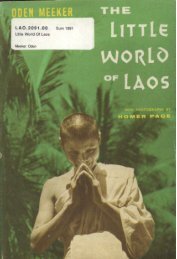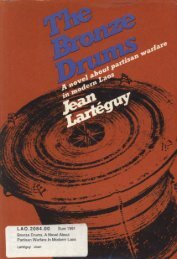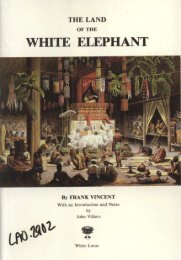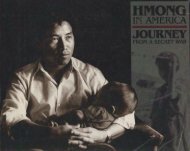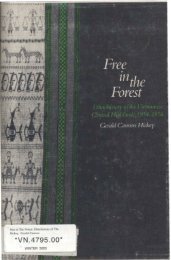and Temple Yards
iutnam From Rice Paddies and Temple Yards - Refugee Educators ...
iutnam From Rice Paddies and Temple Yards - Refugee Educators ...
- No tags were found...
Create successful ePaper yourself
Turn your PDF publications into a flip-book with our unique Google optimized e-Paper software.
VIII. Ly ltnh lang<br />
"Song with 'Tlnh Tang' Endings"<br />
I remember being in a certain friend's house in Saigon when I heard this on the radio. It is central<br />
Vietnamese, very hard to sing correctly ifyou were not born in the region, becawe of the Hue dialect,<br />
which is very particular. Certain gliding tones are very hard to imitate <strong>and</strong> central Vietnamese songs<br />
in general are hard to sing. The person on the tape is from central Vietnam. We sing the same words<br />
in the south, but with adrerent melody <strong>and</strong> scale. The chorusismade upof the names of musicdnotes.<br />
To many people these are nonsense syllables, but when you sing there is something very intimate that<br />
is felt, because they did originate in the folk traclition. In folksongs all throughout Vietnam you will<br />
find these word+-they are very old. Nobody really knows where they came from originally.<br />
"Li T& Tang" is an example of a song style of the Hue area of Central Vietnam.<br />
There are different texts possible for the t h tang style. In fact, any poem of six to eight<br />
syllables can be sung in this style, using the t h tang refrain. The poem used in this recording,<br />
"Lj; Con Sio" ("Song of the Blackbird") is probably the original poem first sung in this genre.<br />
Just as there are many poems that have been set in t h fang style, there are also many<br />
Vietnamese poems that have the same title, "Ly' Con Sio " ("Song of the Blackbird"), but<br />
which may use a different melody <strong>and</strong> style of singing. All of this may seem confusing, but<br />
the exchange of poems, melodies <strong>and</strong> singing styles typical of Vietnamese traditional music<br />
is illustrated through the origin <strong>and</strong> development of this song.<br />
"Ly' ~i;rh Tang'" was a folk song composed by peasants, simple <strong>and</strong> straightfoward<br />
in its melodic patterns <strong>and</strong> at one time very quick in tempo. It gradually metamorphosed into<br />
art music performed by chamber ensembles of Hue. The listening tape presents the "Song<br />
of the Blackbird" as an example of the highly-evolved art song of Vietnam.<br />
Three instruments <strong>and</strong> a women's chorus accompany this song: the din tmh zither,<br />
the dh biu monochord <strong>and</strong> thesong lang or wood clapper. The sound of the monochord with<br />
its harmonics is blended into the music, offering a contrasting tone color to the metallic<br />
quality of the zither. It is the monochord which makes possible the delicate gliding tones of<br />
the accompaniment. Those not of the tradition who wish to perform this song authentically<br />
should attempt the difficult task of adjusting their voices slightly lower than the second <strong>and</strong><br />
sixth degrees of the scale (i.e. about 20-30 Ellis cents lower than B <strong>and</strong> F#). Based on a<br />
common Vietnamese pentatonic scale, the flattening of notes produces for the informed<br />
listener a sweeter melody which consequently inspires arelaxed mood. Gliding tones of the<br />
song add to this effect.<br />
Tramhtion:<br />
Who brought the blackbird to the other side of the river?<br />
She will fly away when given the chance.<br />
The mountain is high-who<br />
The ocean is so deep-who<br />
made it that high?<br />
made it so deep?


